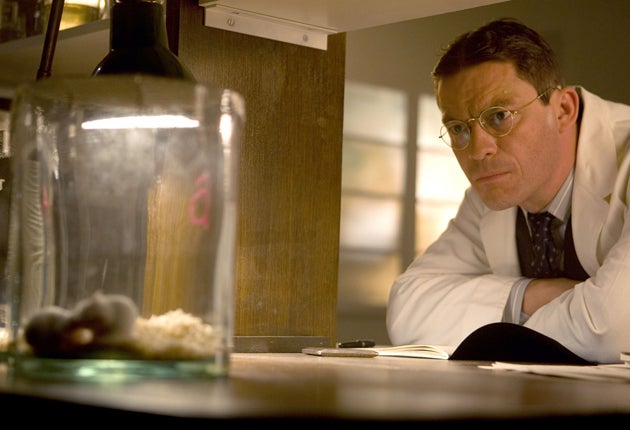Breaking the Mould: the Story of Penicillin, BBC4<br>How the Other Half Live, Channel 4
This account of the discovery of penicillin didn't suffer from the dispensing of a few dramatic liberties

Alexander Fleming was "the man who discovered penicillin" like Jimmy Stewart was the man who shot Liberty Valance, if Breaking the Mould: the Story of Penicillin was to be believed.
Stewart waved his gun in Liberty Valance's general direction, but it was John Wayne who fired the fatal bullet. Fleming may have accidentally stumbled across the medicinal properties of mould in 1929, but it was more than a decade before Howard Florey, Ernst Chain and Norman Heatley, a trio of scientists at Oxford's Dunn School of Pathology, turned penicillin into a viable mass remedy.
Dominic West, he of The Wire, portrayed Florey as a sensitive, uptight Australian – yes, that's right – who refused to compromise his gentlemanly scientific principles for money or prestige. "Patenting puts science on a par with 19th-century colonialism," he told Chain (Oliver Dimsdale), his German-Jewish research partner, who insisted they should copyright their find. "You get there first, stick the flag in, take the money."
In 1938, as war loomed, everyone wanted the pair to work on the development of poisonous gases, but they had a better way to help the war effort. Before penicillin, a scratch could be fatal; Albert Alexander, the first human patient to be treated with the drug (successfully, almost), died because a tiny cut from a rose thorn developed into septicaemia. Still, it took some time for Florey to persuade the Medical Research Council, let alone the pharmaceutical companies, of penicillin's importance.
Alexander's story was one chapter of Breaking the Mould, which charted the years from 1938 to 1942, when the Americans finally joined the war in Europe and began to mass produce penicillin using Florey and his team's method, saving millions of lives then and since. (Chain was proved right: the Americans patented the process and the Dunn School was forced to pay royalties on its own invention.)
If not for the sad tales of Alexander and Johnny Cox – a young boy saved from septicaemia by penicillin, only to die from a ruptured blood vessel – the makers of this fascinating film might have struggled to find humanity in a script largely concerned with single-celled organisms. Thus there were also moments of what felt like subtly contrived drama, be it marital strife for Florey, or professional tension between the chemists and biochemists in his team. For dramatic purposes, too, the film turned Fleming (Denis Lawson) into an arrogant chancer, who snatched the credit for the Oxford trio's hard work. In reality, Fleming called his own public elevation the "Fleming Myth", and shared his 1945 Nobel Prize with Florey and Chain. Florey was equally celebrated, at least in his home country, where his face spent many years adorning the $50 note.
Yet despite the film's varied human stories, I found myself most moved by mice: the mice which Florey injected with killer germs, to be exact, in order to prove the efficacy of penicillin in live subjects. Half of them died, but those with the wonder drug in their bloodstreams continued to nose happily around the sawdust-carpeted jar. On the verge of a world-changing discovery, Florey – modest as ever – merely said, "Hmm. It looks quite promising."
Moving on, nine-year-old Grace Brotherston lives in a very big house in the country. Yolanda Gumpo lives in a cramped council flat in inner London. Grace has a whole drawer filled with horse-riding kit, even though she's never been horse-riding. Yolanda's mother Sharon can't afford to buy her drawers at all.
Welcome to How the Other Half Live, the new show from the makers of The Secret Millionaire, in which a rich family sponsors a poor family for a few months, and all of them learn about themselves and each other. Sharon and Yolanda learnt that not all rich people were mean, while Grace and her mother learned what a difference a simple table and chairs (or a chest of drawers) can make to the life of an underprivileged family. All the participants in this week's debut episode were conspicuously intelligent, amenable and self-aware, and it makes a change to see people crying on TV because other people are so nice, rather than – in Wife Swap, say – because they're so insufferable. Watching Grace and Yolanda tentatively try to articulate their burgeoning friendship was truly touching.

Watch Apple TV+ free for 7 day
New subscribers only. £8.99/mo. after free trial. Plan auto-renews until cancelled.
ADVERTISEMENT. If you sign up to this service we will earn commission. This revenue helps to fund journalism across The Independent.

Watch Apple TV+ free for 7 day
New subscribers only. £8.99/mo. after free trial. Plan auto-renews until cancelled.
ADVERTISEMENT. If you sign up to this service we will earn commission. This revenue helps to fund journalism across The Independent.
On the other hand, it lacked the dramatic tension of either Wife Swap or The Secret Millionaire. There was no moment when the stinking rich revealed themselves, nor was there any danger of the families suddenly going for each other's throats. Maybe next week the rich folks ought to be sneering poshos, and the poor folks ought to blow all their money at the dogs.
Join our commenting forum
Join thought-provoking conversations, follow other Independent readers and see their replies
Comments